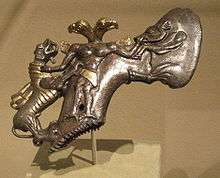Persian-Sassanid art patterns
Persian-Sassanide art patterns have similarities with the art of the Bulgars, Khazars, and Saka-Scythians, and have recurred in Asia. They predominantly feature motifs of fighting animals. Gold was frequently used as a base for their art creations.

Patterns
The characteristic patterns of Persian-Sassanide art exhibit similarities to the art of the Bulgars,[1] Khazars, and Saka-Scythian, and have recurred at different locations in the Central Asia region. A "griffin fighting an elk" motif from the Treasure of Nagyszentmiklós, found in 1799 in what is today Romania, bears similarities with another griffin & elk motif discovered in the tombs of Hsiung-nu[2] (early Huns, also Xiongnu) during Colonel Pyotr Kuzmich Kozlov[3][4] expedition (1907–09) near Urga (Outer Mongolia).[5][6][7]
A gold symbolization of "animals-in-fight" has been also found in the vicinity of the city of Turpan,[8] the principal crossroad of the northern Silk Road. Golden "animals-in-fight" have also been identified as 3rd – 2nd century B.C. Mongolia (or southern Siberia), being characteristic of Hsiung-nu or Xiongnu.
The Art of the Nomads
The early history of the Nomads is not well recorded, which changed after their contact with cultures possessing written history. Nomadic people of the vast steppes of Asia were a major force in history.[9] Their power was not in the empires they built, but rather the turmoil they created among ancient civilizations such as China or Persia, impacting their historical development substantially.[10] It is believed that the nomads ranged widely, forever moving on for sake of richer grazing for their horses and sheep. Migrations were often seasonal. Their skill at extracting gold was unprecedented. In summer, during the tribe's seasonal migration, a fleece would be weighted on a riverbed to collect particles of alluvial gold. Upon the tribes' return, the fleece would be sheared, burned, and a gold ingot the size of a horse's hoof would result. The tay tayak (the horse's hoof) was a unit of gold for a long period, which was used as a measure of an amount of golden metal rather than money, since gold was not fabricated as currency. Using gold was a spiritual practice, as emblems of priestly office, prizes for physical prowess in ritual sport, or as adornment of the sacral ceremony of marriage.[11]
References
- Bulgarian's Treasures from the past by Ivan Venedikov, Sava Boyadjiev and Dimiter Kartalev, Foreign Languages Press Sofia 1965, pp. 345-55
- The Empire of the Steppes, a History of Central Asia by Rene Grousset (transl. by Naomi Walford), Rutgers University Press, 2005, p.25
- Buddha: Radiant Awakening by Jackie Menzies, Sydney, Art Gallery of New South Wales, 2001
- Wildlife of the Tibetan Steppe by George B. Schaller, University Of Chicago Press, 2000, p.11
- Discoveries of the Kozlov Expedition by W. Perceval Yetts, he Burlington Magazine for Connoisseurs, Vol. 48, No. 277 (Apr., 1926), pp. 168-185
- The Pazirik Burial of Altai by Eugene A. Golomshtok, M. P. Griaznov in American Journal of Archaeology, Vol. 37, No. 1 (Jan. - Mar., 1933), pp. 30-45
- Recent Russian Archaeological Exploration by W. E. D. Allen in The Geographical Journal, Vol. 69, No. 3 (Mar., 1927), pp. 262-264
- The Old Silk Road - From Xi'an to Pamir, Chapter XIII: A Tour of Turpan by Bi Yading, Chinese Intercontinental Press (CIP) 2003, p.121 (ISBN 7-5032-2125-9)
- The Perilous Frontier by Thomas J. Barfield, lackwell Publishers, 1989
- Warriors of the Steppe by Erik Hildinger, De Capo Press, 1997, pp. 57-92
- Kazakhstan, Coming of Age by Michael Fergus and Janar Jandosova, Stacey International 2003, p.106 (ISBN 1-900988-615)
See also
- Iranian art
- History of decorative arts
- Toreutics
- Asian art
- Treasure of Nagyszentmiklós
- Hunnic Empire
- Xiongnu
- Scythian art
- Thraco-Cimmerian
- Turko-Persian tradition
